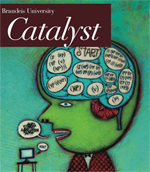Explore the latest issue of Catalyst
The university's research magazine covers music, computational lingustics and much more
 |
| Download the spring 2010 issue of Catalyst |
Why Your Computer Doesn't Understand You
Therapist: Hello, I am Eliza. How can I help you?
Patient: I need my head shrunk really fast.
Therapist: Why did you say your head shrunk really fast?
Patient: I didn’t say it shrunk. I said I need you to shrink it.
Therapist: You are being a bit negative.
Patient: I’m going to jump off a bridge. I guess you could call that negative.
Therapist: Do you wish to guess me?
Patient: No, I wish to swing from a tree screaming nasty words.
Therapist: You are being a bit negative.
Patient: Just as I thought; you can’t help me. Life stinks. Don’t you think life stinks?
Therapist: Oh, I think life stinks.
Believe it or not, dialogues like this one featuring MIT computer scientist Joseph Weizenbaum’s program Eliza riveted the nascent artificial intelligence community forty-five short years ago. Designed to simulate a Rogerian psychotherapist, Eliza parroted back key phrases so convincingly that some users scarcely believed they were speaking to a machine. Despite the awkward phrasing and frequent errors, philosophers, linguists, and computer scientists the world over thought that the day when you could comfortably converse with a robotic assistant was just around the corner.
Fast-forward almost half a century and you’ll find another generation of scholars far more cautious in their estimate of exactly when you’ll be able to trade gossip with R2-D2, C-3PO, or, for that matter, your automobile. Just think about the chats that take place when you are, say, on hold with American Airlines, and you’ll realize that Eliza, history’s most famous therapist wannabe, was but a chimera.
easily confused cybersources
It’s not that progress has not been made. If you want to know yesterday’s sports scores, learn whether your neighbor’s house is for sale, or get the names of Snow White’s seven dwarves, you’ll surely be able to find your answer with a few clicks of the mouse. You can get reasonably accurate directions from your TomTom and dispute consumer problems with a robotic customer-service agent on eBay. But try to ferret out more open-ended data—say, what books have been written about post–Civil War reconstruc tion since 1942—and you’ll confuseyour cybersources woefully.
 |
| James Pustejovsky |
teaching smart computers to think
In short, those “smart” computers can be pretty dense compared to the more sophisticated and nuanced communica tions that engage the human brain—a situation that graduate students in a new MA program at Brandeis are trying to correct.
“Human beings, even by the age of three or four, do an amazing job at understanding words in context, with all their different nuances and meanings,” explains Pustejovsky, who created a new graduate program in computational linguistics. “You can give a computer a trillion numbers and it will make sense out of them. But if you tell a computer, ‘When the alarm rang, Johnny got up from his desk, went out the door, and left the house,’ it won’t be able to follow the story. It can’t figure out what happened, why, or in what order.”
Indeed, it was an underestimate of how much knowledge the human brain really contains that caused mid-twenti eth-century artificial intelligence pioneers to misjudge the enormity of the task before them. Discovering how the brain was “hardwired” and then mimicking those processes to produce machine “intelligence” sounded infinitely more doable to Weizenbaum’s colleagues than it does to contemporary researchers.
But the difficulty doesn’t dilute the thrill of the quest, says Pustejovsky, who for the past twenty years has led a Brandeis research group trying to teach a computer to visualize and re-create a simple scenario like Johnny’s.
the dark matter of semantics
“If you understand English,” Pustejovsky notes, “you can create a spatial and temporal narrative about Johnny. You understand the implied context: The desk was in his house, there was a chair at the desk, and to get to the door Johnny changed his posture and walked. He probably turned a doorknob. Understand ing the narrative’s hidden meaning is a large part of artificial intelligence, and all our efforts are aimed at building an algorithm that will make it possible for machines to do that.”
Understanding this complex subtext (Pustejovsky calls it the “dark matter” of semantics) involves multiple parameters in the brain that he and his team are striving to replicate in the computer. Noting that such efforts involve studying the way children learn to tell stories, Pustejovsky says, “I’m not a cognitive psychologist, but I am really interested in cognitive development, because these computational models will succeed only insofar as they reflect the way we ourselves learn.”
Mathematically inclined as a youngster, Pustejovsky first became curious about language when as a high-school student he went on a scuba-diving trip in Mexico. During a day ashore, he visited Mayan ruins and was riveted by the hieroglyphs he saw.
Although the youth entered MIT with the intention of majoring in electri cal engineering or math, he heard in his sophomore year about a fascinating syntactical analysis class his roommate was taking with world-renowned linguist Kenneth Hale. It was the first year of a new undergraduate degree program in linguistics and philosophy, and Hale shared faculty billing with other super-stars like the linguist Noam Chomsky and John Robert Ross, a syntactician.
“That day,” Pustejovsky says, “I dropped physics and signed on for Ken’s class. Within two weeks, I had dropped two more courses and was enrolled in three linguistics classes.”
Pustejovsky was no polyglot. In fact, he grew up in a bilingual English- and Czech-speaking home in Texas without amassing a Czech vocabulary of more than four dozen words. Instead, it was the technical aspects of language that fascinated him.
“Linguistics was analytic, and it was a lot like math,” he says. “It was pattern analysis, really, looking for the structure of language. I wasn’t interested in the emotive content, and I certainly was not drawn in by the literary aspect; I had never been excited by English classes. It was the scaffolding, the underlying architecture of language, that got my attention.”
applying mathematical principles to language
By making logical and algebraic connec tions, Pustejovsky realized, he could apply mathematical principles to language. This enabled him to mine various tongues for similarities and differences in word order, sentence construction, subject-verb agreement, and other properties of speech that shed scientific light on the brain’s innate ability to receive and send communications. It was like solving an arcane and very complex puzzle.
After graduating from MIT in 1978, Pustejovsky received a DAAD grant—a German Fulbright Scholarship—to explore linguistics and philosophy at Philipps University in Marburg, Germany. In 1985, he received a doctorate in linguistics from the University of Massachusetts at Amherst, then stayed around for an eighteen-month postdoc in artificial intelligence. After joining the Brandeis computer science faculty in 1986, he continued to do linguistics research, often with funding from the National Science Foundation, National Institutes of Health, or DARPA (Defense Advanced Research Projects Agency), and to publish theoretical linguistics articles in scholarly journals.
Linguistics classes, however, took place in Brandeis’s psychology depart ment until 2005, when the undergraduate linguistics program was reorganized as an interdepartmental program. Pustejovsky joined the program faculty and now serves as chair. The program is designed to provide a broad, liberal-arts view of linguistics, while the new master’s program concentrates more heavily on understanding how languages operate in order to put that information to work in artificial intelligence applications.
from english to mandarin
“We chose to move the Brandeis program in this direction because computational linguistics is a growth industry. People need to develop communication and language software for the Web, for industries, for government, and for translation purposes. This is not about creating applications that make money for Google. This is about offering a solid, cross-disciplinary, foundational program that has ties to anthropology, classics, psychology, and neuroscience,” says Pustejovsky, recently named to the TJX/Feldberg Chair in Computer Science.
The fledgling graduate program has two tracks: a five-year BA/MA degree and a two-year master’s program. The first class of five-year students graduated in spring 2009, and the inaugural group of two-year MA candidates arrived last fall. Among them are students who aspire to teach at the university level, develop applications for various industries, and put computational linguistics skills to work deciphering ancient scripts. Other potential applications of computational linguistics include facilitating literary analysis and the study of literary history; performing complex archival tasks; and enabling the cataloging and retrieval of photographs and other images that do not include text, Pustejovsky notes.
“The Holy Grail of computational linguistics and artificial intelligence,” he says, “would be a reliable hand transla tor. Someone could speak English into a device in Beijing, and out would come a translation in Mandarin, with just the right word senses and nuances of meaning.
“If we are successful in our efforts,” Pustejovsky says, “more mundane aspects of our lives will also be impacted by this work. For example, the time will come when you will be able to ask your refrigerator what you need to buy at the market, and it will tell you, ‘Well, the milk has been in here for two weeks, and the fruit section is empty.’ Or maybe it will just print out your shopping list for you.”
--Theresa Pease is senior editor in the Office of Communications and editor of Brandeis University Magazine.





